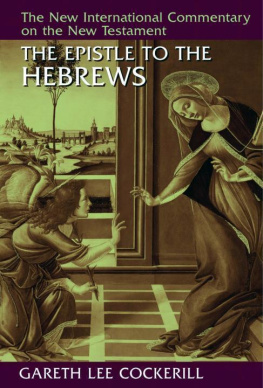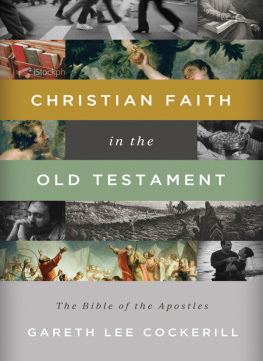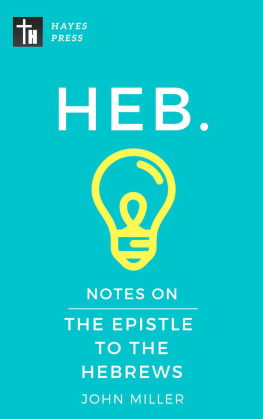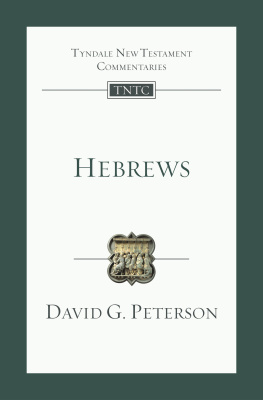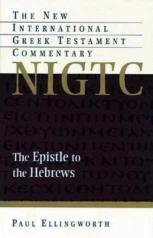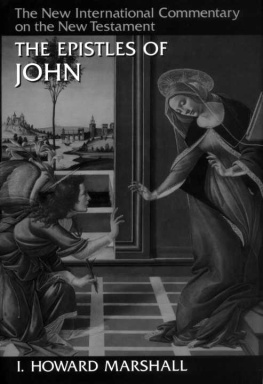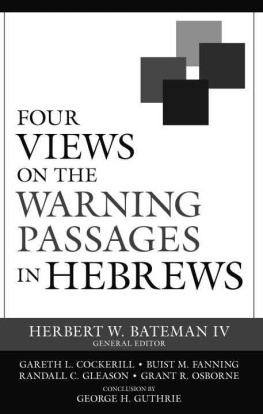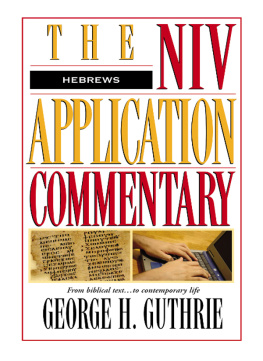General Editors
NED B. STONEHOUSE (1946-1962)
F. F. BRUCE (1962-1990)
GORDON D. FEE (1990- )
GARETH LEE COCKERILL





xii
xiii
xvi
xxiv
Old Testament 72

It is with considerable mixed emotions that I (gladly) introduce this commentary to the reading public. On the one hand, this work represents a signal end of an era for this commentary series, since it is both replacing a commentary by the second general editor (F. F. Bruce) and is the final editorial task of the third general editor, whose onsetting bout with Alzheimer's disease has necessitated his relinquishing this task, even though a few additional replacement volumes are still in the mill, as it were. I have had the privilege of working with Gary Cockerill quite closely over the past several years, and am pleased heartily to commend this commentary to the primary intended readership of this series - the proverbial "busy pastor" and biblical students in colleges and seminaries. The reader will quickly recognize that the author is not only well acquainted with the secondary literature on this great biblical book, but has also brought his own deep love for the author of Hebrews and his work to the task so that it shines throughout these pages. I am glad to be able to commend it to one and all.
GORDON D. FEE
There is no better book for carrying out this mandate than the Letter to the Hebrews.
In our initial conversations concerning this book Professor Gordon Fee asked me to justify issuing a new volume on Hebrews in this series. I suggested that developments over the past decades in the study of ancient rhetoric, in the analysis of Hebrews' structure (particularly through discourse analysis), and in intertextual studies warranted such a venture. I am grateful that he agreed. No NT book is more diligent in presenting the OT Scripture for its Christian hearers than this book, which begins by declaring: "God, who spoke in the prophets.... has now spoken in One who is Son." None of fers a higher degree of rhetorical sophistication. One does not have to embrace all of the methodology advocated by various practitioners of these disciplines to be enriched by their work.
First of all, then, this commentary is based on a fresh analysis of the structure and rhetorical shape of Hebrews. Each individual passage is interpreted with sensitivity to the role it plays within the author's overall strategy for persuading his hearers to embrace the truth he presents and to act accordingly. I believe you will benefit significantly from engaging the full presentation of this structural analysis in the Introduction before proceeding to the exposition of your favorite passage. The opening paragraphs of each section and subsection of the exposition also situate the particular portion of the text under consideration in relation to the whole. It may seem audacious to present yet another structural analysis of Hebrews. I offer this analysis humbly, only after carefully listening to the text of Hebrews, and with deep appreciation for all that I have gained from other analyses. I ask you, the reader, to judge this analysis on the basis of its ability to enrich your understanding of individual passages and of Hebrews as a whole.
This commentary also offers fresh insight into Hebrews' use of the OT. The author of Hebrews understands the relationship between God's word in the Son and previous revelation as one of continuity and fulfillment. His approach has much that can enrich contemporary Christian biblical interpretation. My understanding of this subject as given in the Introduction to this commentary informs the exposition of the commentary proper.
When people discovered that I was writing a commentary on Hebrews they would almost invariably ask, "Well, who wrote it?" One certainly can and must study Hebrews within its first-century environment. In my judgment, however, the evidence available is insufficient to determine with certainty the name of the author or to be overly precise about the location, specific identity, and situation of the recipients. Thus those who base their interpretation on an unduly specific reconstruction of Hebrews' origin are likely to skew their understanding of the book in proportion to the idiosyncrasy of their proposal. Nevertheless, each proposal highlights some aspect of Hebrews. Thus we will survey various proposals in the Introduction not so much to determine which one is correct as to benefit from the insight each provides.
It is necessary to say something about translation, textual variants, and secondary sources. I have done my own translation of Hebrews so that I would not be under obligation to critique a particular version and so that I could make stylistic features and various emphases of the Greek text more readily accessible to the English reader. Many commentaries on Hebrews provide extensive analysis of textual variants. I have addressed textual issues only when they significantly impact interpretation and as part of the exposi tion itself rather than in a separate section. Due to the increased volume of scholarly publication, one can no longer claim to have mastered all of the literature on Hebrews. I have tried to be as comprehensive as possible and to interact with the sources that seemed most helpful. I am glad that the fine commentary by Peter O'Brien appeared just in time for consideration. I regret that my friend David Allen's commentary came just a bit too late.
I owe a great debt of gratitude to many for their help and encouragement. First of all, I am indebted to Professor Fee for giving me this opportunity and especially for his clear feedback on my initial draft of the opening chapters. That feedback set the direction for the whole. I would be amiss to omit my appreciation for my doctoral mentor, Professor Mathias Rissi, although this is not the commentary on Hebrews that he would have written. He first sparked my academic interest in Hebrews and guided my study with both insight and encouragement. My thanks to Ron Smith and Ray Easley, former President and Dean, respectively, of Wesley Biblical Seminary, for arranging my schedule and providing other resources that facilitated this project. Dan Burnett, Director of Library Services for Wesley Biblical Seminary, has graciously responded to my many requests for interlibrary loans. I am especially grateful to Kenneth Elliott, Director of the Library at Reformed Theological Seminary, Jackson, Mississippi, and to John McCarty, the Circulation Director. They cheerfully provided me with bibliographical resources, with a research room that greatly facilitated the completion of this project, and with collegial camaraderie. Milt Essenburg, of Eerdmans Publishing, has given me the encouragement in these final months that he has given to so many other commentators before me.

